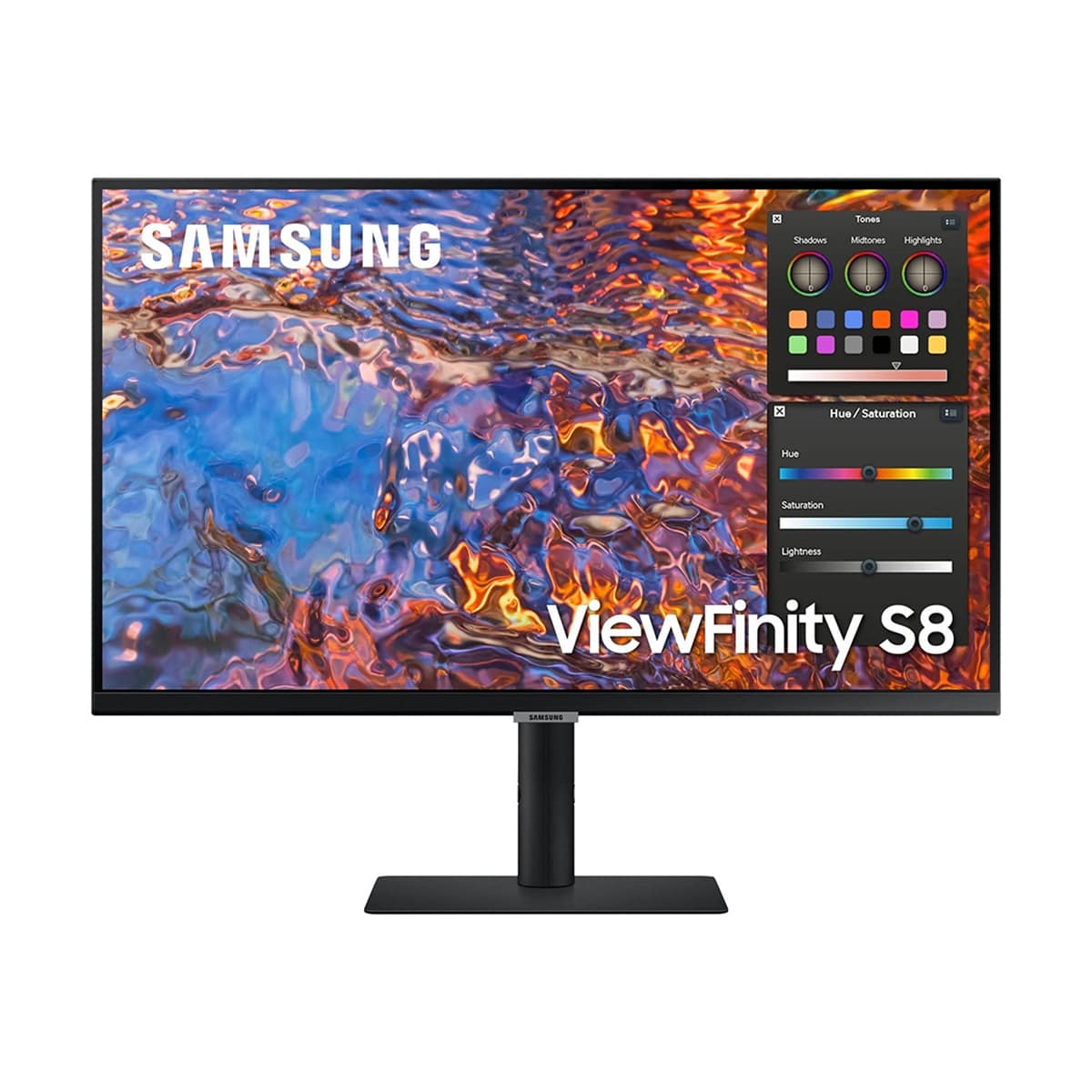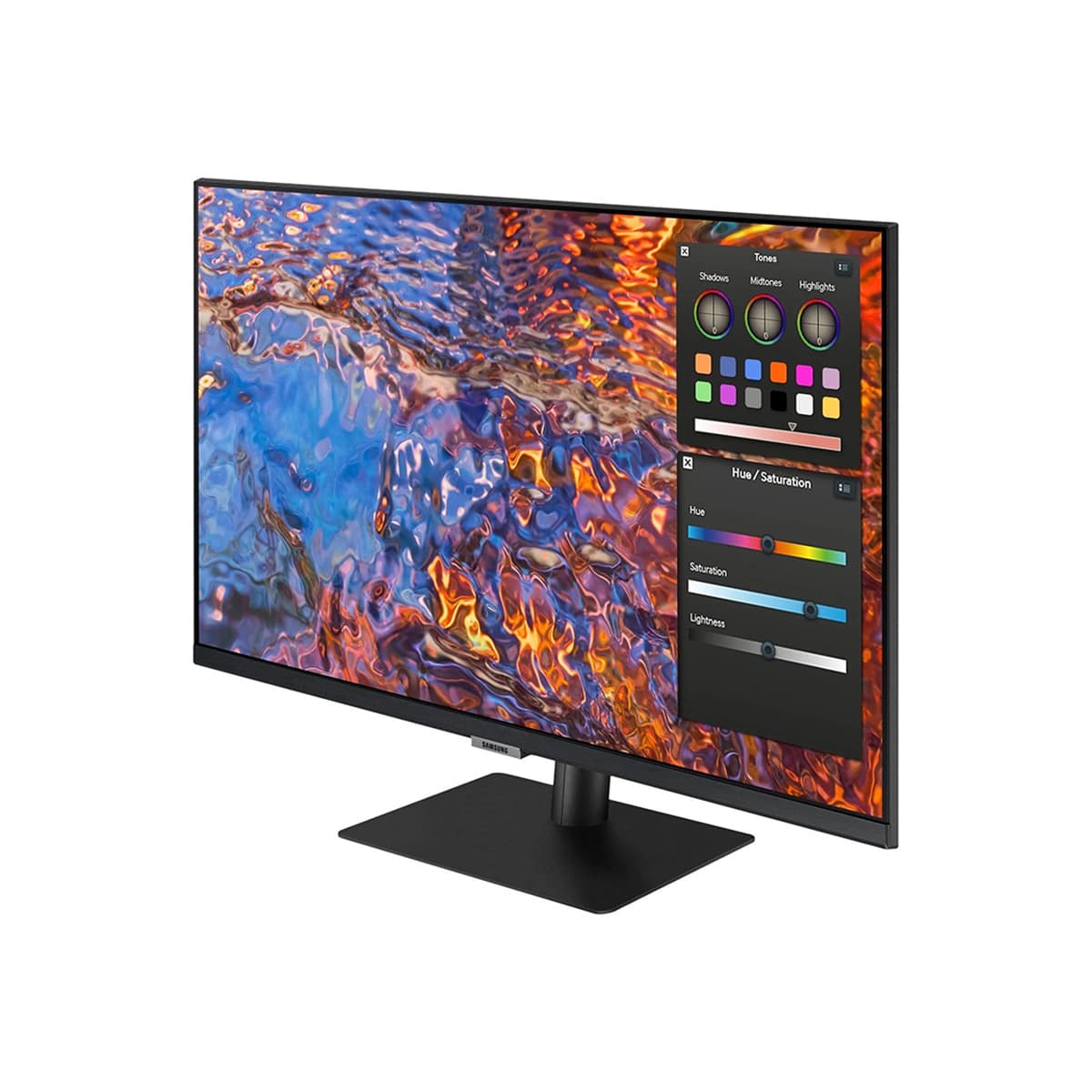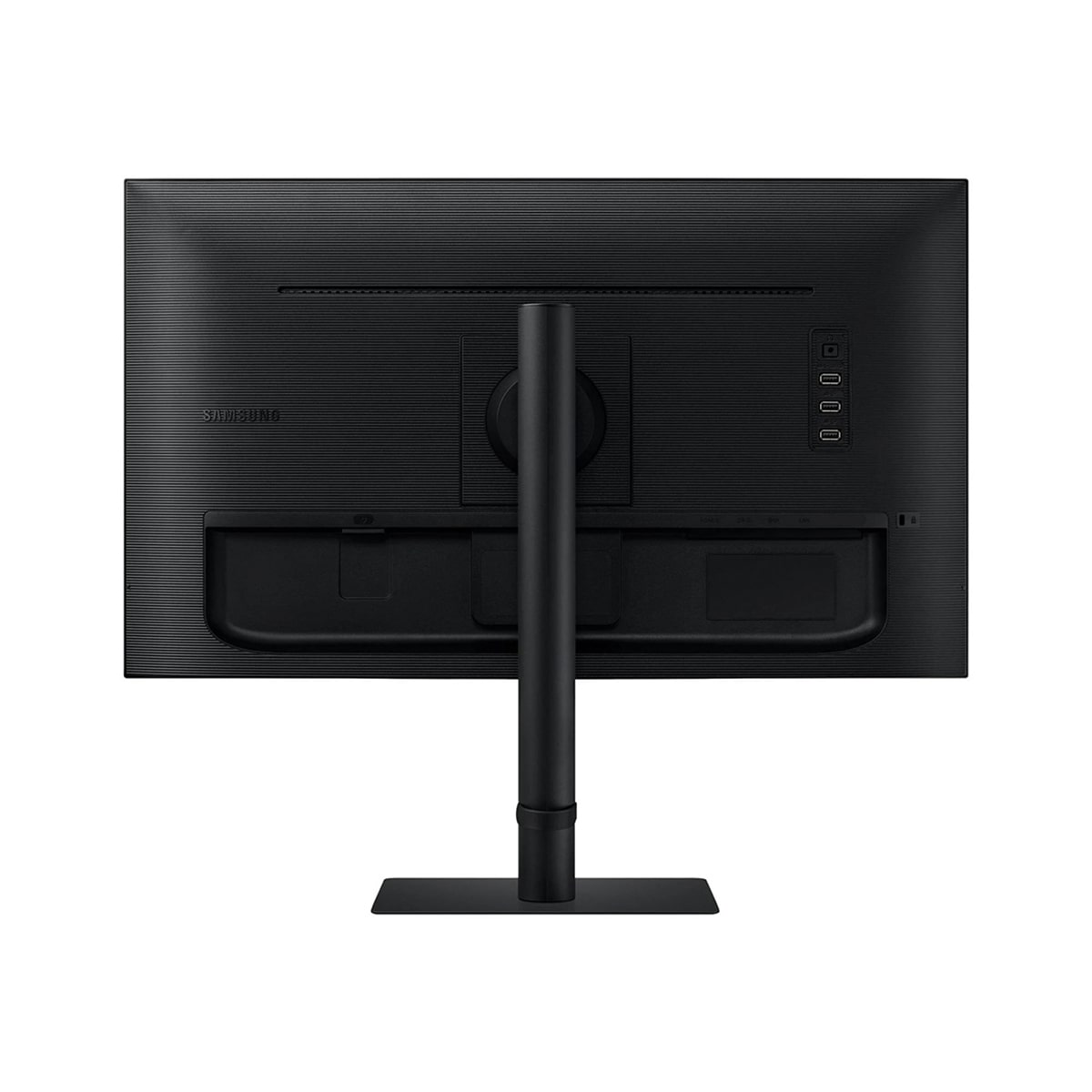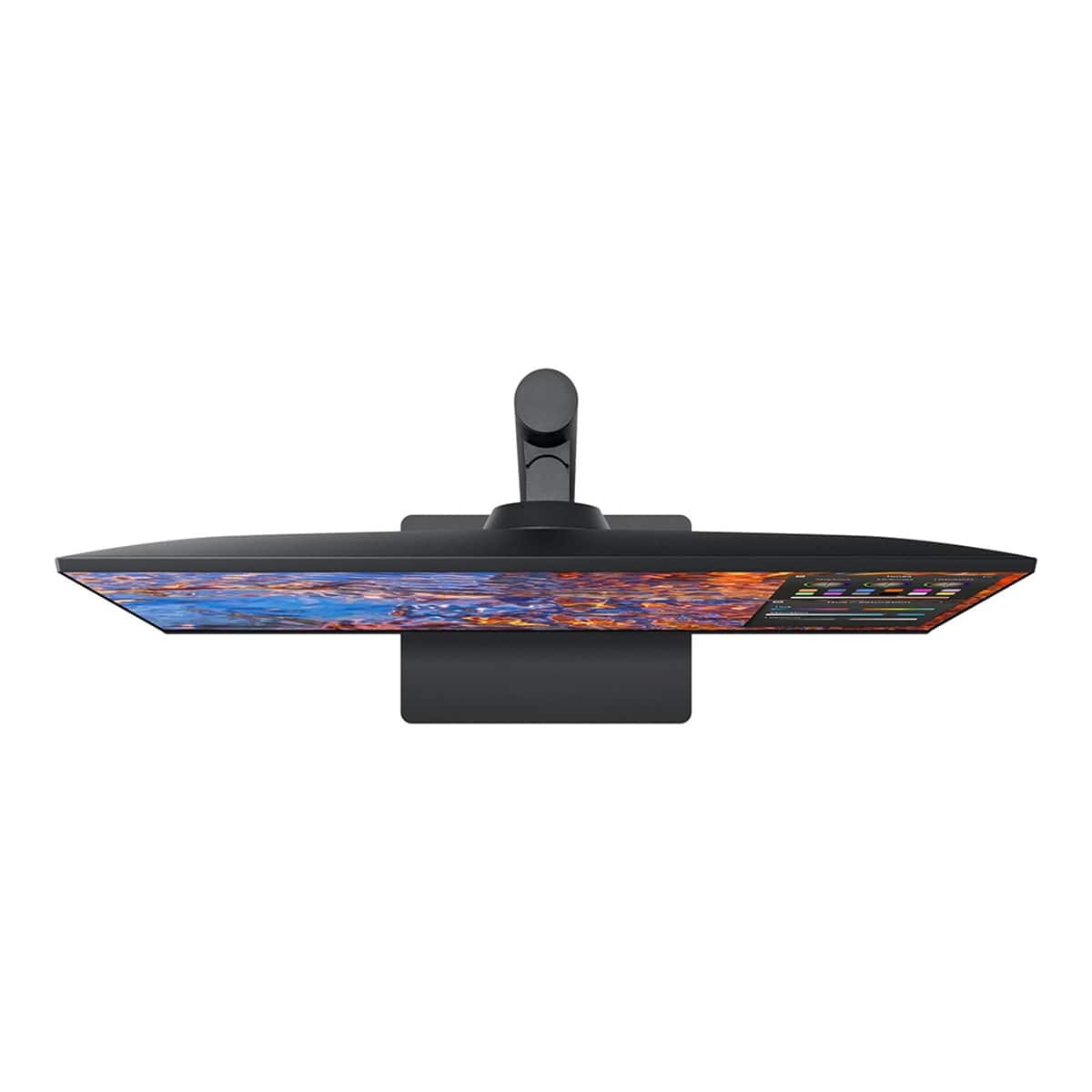The ViewFinity S80D is Samsung’s latest update to its S8 series, specifically crafted for creative professionals and content creators. Positioned slightly below the premium S80UD, the S80D still delivers an impressive 4K HDR10 VA panel that ensures dependable image quality and a solid overall build—though it falls a bit short on the advanced connectivity features found in its higher-end sibling.
Design and Aesthetics Review
The S80D features a minimalist all-black aesthetic that avoids flashy finishes, offering a clean and professional look. The near-borderless display on the top and sides enhances its modern appeal, though the bottom bezel—featuring a Samsung-branded notch—slightly disrupts the otherwise seamless design. Even after extended use, this notch can draw the eye, making the front design feel less cohesive than it could be. A removable or subtler branding option would have been a welcome touch for users focused on visual symmetry.
When rotated into portrait mode, the S80D’s asymmetrical chin becomes more noticeable, giving the monitor an imbalanced appearance. Those seeking a monitor primarily for vertical use may prefer a model with a more uniform frame.
Despite that, the overall construction is commendable. The monitor comes with a durable, all-metal stand that exudes quality and stability. The ribbed texture on the front of the stand adds visual interest, while its placement behind the screen creates a stylish, floating effect that adds to its sleek appeal.
The base of the S80D is impressively slim, occupying minimal desk space while still offering solid stability with virtually no noticeable wobble. This thoughtful design strikes a nice balance between a compact footprint and reliable support.
Overall, the S80D stands out as one of the more stylish monitors currently available. Its clean aesthetic is somewhat marred only by the slightly thicker bottom bezel and the prominent Samsung logo notch. While this is a design choice seen across several brands, we find the edge-to-edge uniformity of models like Dell’s UltraSharp U2724DE more visually appealing.
From a usability perspective, the S80D excels. Assembly is quick and straightforward—just two steps—and the panel connects securely to the stand. The screen supports portrait mode rotation, although its asymmetrical chin design may be distracting in vertical orientation. In landscape mode, users benefit from a full range of adjustments: 30° swivel left and right, -2° to 25° tilt, and 120mm of height adjustment.
These adjustments operate smoothly, with tilt and swivel easily controlled one-handed thanks to the monitor’s sturdy build. Height adjustment requires a bit more effort, typically needing both hands.
In terms of connectivity, the S80D includes both DisplayPort 1.2 and HDMI 2.0 inputs, along with a headphone jack and a USB-B port for activating its USB hub, which offers three USB 3.0 ports. Samsung includes all the necessary cables in the box, along with a soft rubber cable management loop to help keep your setup organized. However, unlike the premium S80UD model, the S80D lacks USB-C and Ethernet ports—something to consider if you’re seeking a more comprehensive I/O setup.
Menu navigation is straightforward, handled via a four-way joystick on the rear of the monitor. This is also where you’ll find quick access to features like Samsung’s Eye Saver Mode for reduced blue light.
Samsung ViewFinity S80D Monitor Review: Display Performance
The S80D is equipped with a 32-inch 4K UHD (3,840 x 2,160) VA panel supporting HDR10. Samsung promises rich visuals with a 3,000:1 contrast ratio, 99% sRGB color coverage, and a brightness rating of 350 nits—delivering up to 1.07 billion colors.
In real-world testing, the S80D held up well. It achieved a measured contrast ratio of 2,923:1 and full 100% sRGB color gamut coverage. However, its performance in wider color spaces was less impressive, with DCI-P3 coverage at 84.1% and AdobeRGB at 77.7%. Color accuracy was also somewhat underwhelming, with an average Delta E of 1.8 and a peak deviation of 5.1—largely due to its handling of reds and darker grayscale tones.
Despite the technical limitations, these color inaccuracies weren’t immediately noticeable during everyday use, though they could be a concern for color-critical work like professional photo or video editing.
On the upside, peak brightness reached a strong 408 nits, and backlight uniformity was consistent across the screen. Viewing angles were excellent for a VA panel, aligning well with Samsung’s 178° specification.
In terms of responsiveness, the S80D offers a standard 5ms response time and a 60Hz refresh rate. While perfectly adequate for general productivity and media use, it may feel a bit sluggish to users transitioning from higher-refresh-rate displays (90Hz or 120Hz), especially those within the same price range.
Daily use of the S80D was enjoyable overall. It maintained consistent image quality in various lighting conditions, and its high pixel density made full use of the 32-inch screen size—offering ample screen real estate for multitasking and creative workflows.
Samsung S8 ViewFinity S80D Monitor: A Solid Performer Worth Considering?
Key Specifications:
- Display: 32-inch VA panel
- Resolution: 4K UHD (3,840 x 2,160)
- Refresh Rate: 60Hz
- Connectivity: DisplayPort, HDMI (1 port), HDCP 2.2, headphone out
- Stand Features: Height adjustable up to 120mm, -2.0° tilt
- Dimensions (with stand): 713.9 x 585 x 220mm
- Weight (with stand): 6.9kg
The Samsung ViewFinity S80D stands out as a reliable, well-rounded monitor with an impressive design and user-friendly setup. It offers a streamlined installation process and includes a practical—though not extensive—selection of ports. The ergonomic stand, with smooth height and tilt adjustments, rivals some of the best we’ve tested in this size range.
Whether you’re placing it in a professional workspace or a home office, the S80D fits in seamlessly—though it’s less ideal for vertical use. It delivers strong core performance across the board, especially in everyday usage and video playback, where its vivid 4K panel shines with rich detail and excellent brightness under various lighting conditions.
That said, its color accuracy, particularly in rendering reds, falls slightly short when scrutinized closely. However, unless your work demands top-tier color precision—like in professional-grade photo or video editing—this won’t be a major drawback.






Leave a Reply